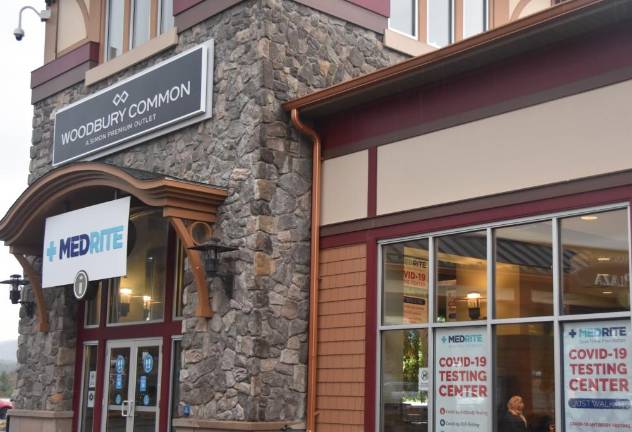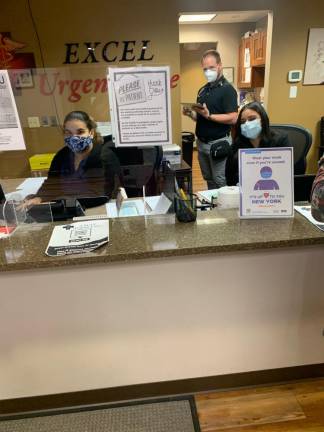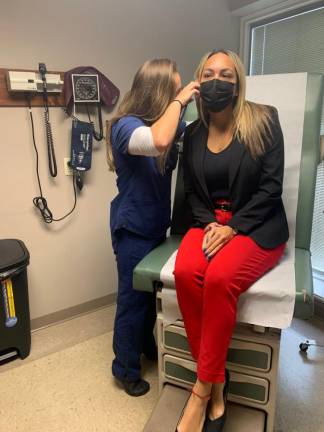The business of COVID brings medicine closer to home
The pandemic. Starting with testing, we’re accessing healthcare in a radically new way.



The outlets at Woodbury Common won’t open for an hour, but one storefront is already lit up and bustling on a stormy weekday morning.
In a stone-façade building that used to be the welcome center, 10 masked people sit among potted palms in a high-ceilinged waiting room. They have dashed through the pouring rain to get here: the MedRite Urgent Care that offers COVID testing with a 24-hour turnaround.
Incongruously sandwiched between the Mulberry and Converse stores, this walk-in clinic is part of a patchwork of easy-access sites that have emerged as critical infrastructure in the past 18 months – and may end up transforming the way Americans access medicine.
With the Delta variant on the march, the nasal swab has become a routine chore: before traveling or seeing grandparents, attending a concert or a wedding; after a COVID exposure; at the first hint of a runny nose; and soon, as a weekly job requirement for unvaccinated workers at businesses with 100 employees or more.
Trying to meet the community where it is
The country’s 10,600 urgent care clinics – standalone “doc in the box” outfits that pivoted to COVID testing early in the pandemic – are slammed and struggling with staffing shortages, even as new ones open up across the region to meet the demand.
“We’ve had to open a few facilities to better meet the needs of people,” said Emmy Ansinelli, marketing director of MedRite, which has added 10 new locations in three states since 2019. “People don’t want to really travel far from home to make sure they don’t have COVID. We’ve tried to meet the community where it was at.”
Along with the location in Woodbury Common, the company has new urgent cares in Spring Valley, N.Y., also in a shopping center; and Springfield and Passaic, N.J.; and another one coming on Manhattan’s Upper West Side.
Triple the normal volume of traffic since last spring
Goshen Excel Urgent Care has been seeing double to triple the normal volume of traffic since last spring. On any given day, the line of people awaiting COVID tests might be out the door, with more idling in their cars in the parking lot.
But it’s not just COVID tests, said Dr. Anthony Ruvo, president and CEO of MedExcel USA. They have also been treating patients with a lot more anxiety-related problems than usual and people who want to avoid the emergency room and its risk of COVID exposure.
“We believe the current volume will drop, but will remain above pre-COVID volumes, as healthcare has and is being redefined,” said Ruvo.
Testing is not going away anytime soon
A brief spate of confidence this spring fueled the hope that testing was on the fast track to obsolescence.
“I think we all anticipated it would go away once people got vaccinated,” said Lou Ellen Horwitz, CEO of the Urgent Care Association, of the surging demand for COVID testing.
Not so. As the Delta variant surged, government health officials recently reversed their earlier guidance that vaccinated people could largely skip testing. Home self-tests have been flying off drugstore shelves since early September, prompting Walmart and CVS to post a limit on how many kits customers can buy.
And testing requirements keep piling up, whether you’re looking to fly to Hawaii, go to a concert, or just go to work.
“Having all these additional testing requirements, on top of tests sick people are getting, is indicating that it will not go away for awhile,” said Horwitz. “Which is very stressful on the system. Centers have been overwhelmed since April of 2020 with high volumes, and understaffed, just like other healthcare facilities.”
“We’re all hoping to move on from this,” said Ansinelli, of MedRite. “This Delta variant has shown one thing: it’s a very resilient virus. Even if you’re vaccinated you can still transmit the disease. I don’t know at what point we’ll see traffic for testing go down.”
Regular testing is a crucial tool to resuming life in the COVID era, says Dr. Raymond Basri, the Orange County cardiologist and volunteer firefighter who opened the Woodbury MedRite Urgent Care last fall. The building has had a perfunctory makeover from its past life as a welcome center. The cavernous space, originally a meeting place for group excursions and a way station for weary tourists, is structurally unchanged. The major change appears to be a beige curtain separating the public-facing waiting area from the back, where space dividers are arranged into four makeshift exam cubicles in which noses are summarily swabbed. It’s bare bones medicine, stripped of the frills and much of the overhead associated with a hospital. Within 24 hours, as advertised, a text and phone call alert patients that their COVID test result is ready.
“In my opinion we just don’t test enough,” said Basri in a recent YouTube video. “Getting tested once a week and finding where these variants are – because the reference labs will type some of the positive tests ... will give everybody better information on how to move forward. If it’s symptoms of hay fever, allergies, watery eyes, hoarseness, all of these could be COVID. So our threshold to do a test should be very low,” he said. “So let’s do the right thing here, let’s get tested, particularly in the first responder population.”
‘Covid testing??? At a shopping mall!!!?’
Not everyone is pleased with the new tenant, so unlike the swanky outlets of Woodbury Common. “Covid testing??? At a shopping mall!!!? GROSS!!!!” wrote Bergen County, N.J., real estate agent Katie Riley on Instagram.
“Our urgent care is located right off the parking lot. Wouldn’t you want to know that the people shopping around you are COVID-free?” @medriteatwoodburycommons replied.
Healthcare worker Kristen Andersen Carner of Monroe called it a “horrible idea” to open an urgent care at a shopping center. “Oh I think I have COVID , but while I am here I am just going to run into a few stores,” wrote Carner on Instagram. Sure, people were advised to stay home if they had active symptoms, but would they? “You are giving people too much credit for being honest,” she wrote.
“Trying to keep everyone safe and our economy open!” replied @medriteatwoodburycommons.
Who’s making money? Not the little guys
COVID testing seems like big business, and for some players, it is. Abbott Laboratories, maker of the at-home test BinaxNOW that’s available over the counter at drugstores – for $24 for a two-pack, if you’re lucky enough to find one – made $2.2 billion on COVID testing in the first quarter of this year, tripling its global net earnings. Cases of price gouging have made headlines, with providers billing for hundreds or even thousands of dollars for a COVID test whose median cost, according to the Kaiser Family Foundation, is $148. These shenanigans will eventually drive up insurance premiums for all of us, say analysts.
At the level of the typical walk-in clinic, however, the margins are slim on COVID-related procedures, said Horwitz. Congress has required private insurers to cover the cost of COVID testing, but that’s not always the reality. Sometimes the test costs more to administer and process than insurance companies will reimburse, and some insurance companies are no longer covering asymptomatic testing. Urgent care owners have gone into crippling debt waiting for reimbursements, she said.
“We’re not doing it for the money,” said Horwitz. “It’s really allowed us to come off the sidelines of the healthcare system, but as far as making a ton of money, no, it’s been very very difficult.”
Not just for COVID testing
While a couple hundred new urgent cares have opened since the pandemic hit, that expansion is consistent with the growth the industry’s been seeing for a decade, she said.
The only COVID-related procedure that holds promise as a moneymaker is monoclonal antibody treatment, said Horwitz. The therapy, which helps prevent severe COVID symptoms, is fully covered by insurance. But that, too, might turn out to be a loser after paying a nurse to administer the treatment.
Between raising salaries to attract employees, buying personal protective equipment, fighting with insurance companies to get reimbursed and getting patients in and out in something resembling the standard 45 minute timeframe, the past 18 months have been an exercise in constant adaptation, said Dr. Ruvo of MedExcel.
They’ve also been priceless for the industry’s visibility. Nearly half of the 28 million patients who visited urgent cares last year were new visitors, according to a survey by software company Experity. People who first came in for a COVID test have already begun returning, said Ansinelli, whether for a flu shot, an X-ray to see if that ankle is broken or just badly sprained, or pediatric visits from bumps and stitches to school physicals.
And, of course, more COVID testing.
In the age of COVID, said Ansinelli, people seem to be developing a heightened awareness of their health, empowered by the ability to drop in for a medical visit in their own neighborhood.
“And what this disease has shown us,” she said, “is if you are able to monitor it and prevent it from spreading, you’re winning.”